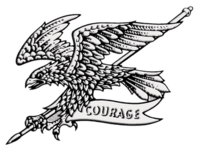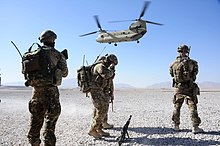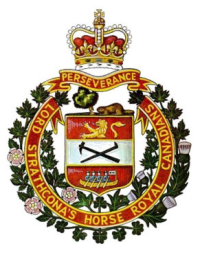
Lord Strathcona's Horse (Royal Canadians) (LdSH[RC]) is a regular armoured regiment of the Canadian Army and is Canada’s only tank regiment. Currently based in Edmonton, Alberta, the regiment is part of 3rd Canadian Division's 1 Canadian Mechanized Brigade Group. Members of the regiment are commonly called Strathconas or Strats as a short form. It was one of the last regiments in the British Empire to be created and raised by a private individual, Donald Alexander Smith, 1st Baron Strathcona and Mount Royal.

The Royal Canadian Hussars (Montreal) (abbreviated as RCH) is an armoured reconnaissance regiment of the Primary Reserve in the Canadian Armed Forces. It is one of the oldest cavalry regiments in North America, tracing a direct history to the Montreal Volunteer Cavalry formed in the late eighteenth century. Its Colonel-in-Chief is Her Royal Highness, the Princess Royal, and its allied regiment is the Queen's Royal Hussars. Its mission consists of supporting the Regular Force in operational deployments, peacetime tasks, and supporting the civilian authorities.

The Royal Yeomanry (RY) is the senior reserve cavalry regiment of the British Army. Equipped with Supacat Jackal variants, their role is to conduct mounted and dismounted formation reconnaissance. The Regimental Headquarters is located in Leicester, with squadrons in Fulham, Nottingham, Dudley, Croydon, Telford, and Leicester. The regiment is part of the Royal Armoured Corps and is only reserve cavalry regiment to resubordinate into regular brigade as part of the Future Soldier Programme, which in turn arose from the Integrated Review of Security, Defence, Development and Foreign Policy published in March 2021.

The Royal Canadian Dragoons (RCD) is the senior armoured regiment of the Canadian Army by precedence. It is one of three armoured regiments in the Regular Force and forms part of the Royal Canadian Armoured Corps.

Queen Alexandra's Mounted Rifles (QAMR) is an armoured regiment of the New Zealand Army and forms part of the Royal New Zealand Armoured Corps. The regiment was formed in 1864 and is currently an armoured cavalry unit equipped with NZLAV.

The Royal Australian Armoured Corps (RAAC) is an administrative corps of the Australian Army. It provides the Australian Defence Force's Armour capability, which performs the function of mounted combat. Armour combines firepower, mobility, protection and networked situational awareness to generate shock action and overmatch in close combat. Armour is an essential element of the combined arms approach that is employed by the Australian Army.

1st Armoured Regiment (1AR) is an armoured regiment of the Australian Army and is the senior regiment of the Royal Australian Armoured Corps (RAAC). Formed as an armoured unit in the Australian Regular Army on 7 July 1949, the regiment squadrons served during the Vietnam War operating Centurion tanks. More recently the regiment has contributed small groups and individuals to operations in East Timor, Iraq, Afghanistan, the Solomon Islands and elsewhere. Currently the unit is based in Edinburgh, South Australia and was re-roled in 2024 as an experimentation unit.
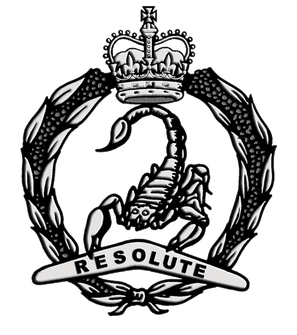
The 3rd/4th Cavalry Regiment is an armoured unit within the Australian Army's Royal Australian Armoured Corps. Formed in 1981 with the amalgamation of the 3rd Cavalry Regiment and the 4th Cavalry Regiment, from 1986 to 2014 the unit consisted of an independent squadron, B Squadron 3rd/4th Cavalry Regiment, within the 3rd Brigade in Townsville, Queensland. From 2017, B Squadron 3rd/4th Cavalry Regiment has been the training support and logistics squadron within the School of Armour at Puckapunyal in Victoria.

The Australian Light Armoured Vehicle (ASLAV) is an eight-wheeled armoured reconnaissance vehicle of the LAV II family used by the Australian Army. It was built by General Dynamics Land Systems Canada, and developed from the U.S. Marine Corps' LAV-25 and Canadian Army's Bison armoured fighting vehicles.
The Household Cavalry Regiment (HCR) is an Armoured Cavalry regiment of the British Army based in Bulford Camp in Wiltshire. It is the brother regiment of the Household Cavalry Mounted Regiment (HCMR) based at Hyde Park Barracks in London - both regiments together form the Household Cavalry (HCav). The Household Cavalry Regiment was formed in 1992, under the Options for Change reforms, by the union of The Life Guards and The Blues and Royals in order to preserve the distinct identities of the regiments. A precedent for the Household Cavalry Regiment has previously been set by the Household Cavalry Composite Regiment - active during the Anglo-Egyptian War, the Second Boer War and latterly during both the First and Second World Wars.
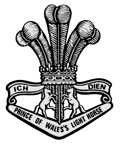
The 4th/19th Prince of Wales's Light Horse is a cavalry regiment of the Australian Army. The regiment in its current composition was formed in 1948, when the Citizens Military Force (CMF) was re-raised after the completion of the demobilisation process following the end of the Second World War, through the amalgamation of three previously existing regiments. Through these predecessor units, 4/19 PWLH can trace its lineage back to the 19th century and today it is the custodian of the battle honours earned by these units. The regiment had a Regular squadron, 1 Troop 4th/19th Prince of Wales Light Horse Regiment, which was posted to South Vietnam in 1965 where it was attached to 1 RAR operating out of Bien Hoa Province. It returned to Australia on 28 May 1966 and became part of the Regular cavalry units that continue to exist in the Australian Army today. These units subsequently served during the Vietnam War and many of their personnel continued to wear regimental accoutrements while in South Vietnam.

The 2nd/14th Light Horse Regiment is a regiment of the Australian Army and forms part of the Royal Australian Armoured Corps. The regiment is an Australian Light Horse unit, and has been widely romanticised and popularised in literature and poetry throughout the 20th century. The unit sentimentally traces its lineage to 1860 and is the oldest Australian Regular Army unit through antecedent units the 2nd Moreton Light Horse (QMI) and the 14th West Moreton Light Horse (QMI). The regiment is assigned to 7th Brigade based in Brisbane and is equipped with the Boxer Combat Reconnaissance Vehicle, the ASLAV Reconnaissance Vehicle and the M1A1 Abrams main battle tank.

The Al Muthanna Task Group (AMTG) was a battlegroup that formed Australia's main ground force contribution to the Multinational force in Iraq. The AMTG was established in April 2005 and ceased to exist in July 2006 when the Australian force was relocated to Dhi Qar Governorate as Overwatch Battle Group (West).

The 5th/7th Battalion, The Royal Australian Regiment is a regular littoral infantry battalion of the Australian Army. The battalion is based at Robertson Barracks in Holtze, Northern Territory and forms part of the 1st Brigade. It was originally formed in 1973 by the linking of the 5th and 7th Battalions of the Royal Australian Regiment together. It was de-linked on 3 December 2006, as part of the expansion of the Australian Army whereby the 5th and 7th Battalions of the Royal Australian Regiment were re-established as separate battalions. As part of the 2023 Defence Strategic Review, the 5th/7th Battalion were to be relinked which occurred on 10 December 2024 and raised as a littoral light infantry battalion
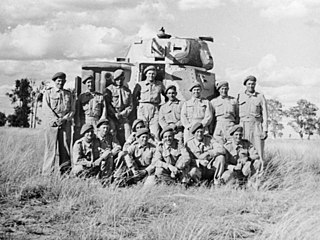
Armoured units made a relatively small, but important, contribution to Australia’s war effort during World War II. While Australia formed three armoured divisions and two independent armoured brigades during the war, Australian armoured units only saw action as independent regiments and companies supporting larger infantry formations. Early actions were fought in the Middle East by the divisional carrier regiments that supported the 6th, 7th and 9th Divisions, fighting in Libya, Egypt and Syria in 1941–42, before the Australian divisions returned to Australia in 1942–43. During the early fighting in the Pacific, there was a limited role for armoured formations, although one armoured regiment – the 2/6th – took part in the fighting around Buna–Gona in late 1942. Later in the war, though, during the Huon Peninsula, Bougainville and Borneo campaigns of 1943–45, several armoured units were used by Australian forces in the infantry support role.
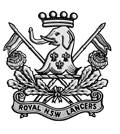
The 1st/15th Royal New South Wales Lancers is an active Australian Army Reserve Light Cavalry regiment. The regiment has its headquarters at Lancer Barracks in Parramatta, a suburb in Western Sydney, New South Wales. Lancer Barracks is the oldest Military Barracks on mainland Australia and dates from 1819.

The Cavalry Corps (CAV) is one of the combat support corps of the Irish Army. In peacetime, the Cavalry carries out various duties in Aid to the Civil Power, such as:

Armoured reconnaissance also Combat reconnaissance vehicle is the combination of terrestrial reconnaissance with armoured warfare by soldiers using tanks and wheeled or tracked armoured reconnaissance vehicles. While the mission of reconnaissance is to gather intelligence about the enemy with the use of reconnaissance vehicles, armoured reconnaissance adds the ability to fight for information, and to have an effect on and to shape the enemy through the performance of traditional armoured tasks.

The 3rd/9th Light Horse is a Reserve light cavalry regiment of the Australian Army based in Smithfield, South Australia. It is constituted of a single squadron. It is part of the Royal Australian Armoured Corps (RAAC), the regiment is attached to the 9th Brigade, and currently operates Hawkei Protected Mobility Vehicle - Light (PMV-L). On 26 October 2022, 9th Brigade transitioned as a Direct Command to Forces Command (FORCOMD) as part of an Army wide transformation. 3rd/9th Light Horse, 1st Armoured Regiment officially commenced on 1 November 2022.
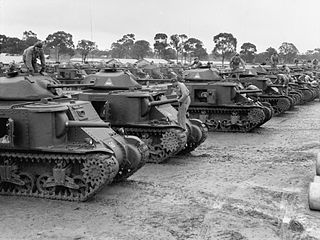
The Australian Army has used tanks from after the First World War, through the interwar period, the Second World War, the Cold War and to the present day. Throughout this period the Army has primarily been a light infantry force, with its tanks mainly being used in the direct support role. The Australian Army's tanks have seen combat during the Second World War and the Vietnam War, where they proved successful despite some of the designs employed being considered obsolete. The first Australian tanks were a small number of British medium and light tanks which were operated mainly for training purposes during the 1920s and 1930s.
